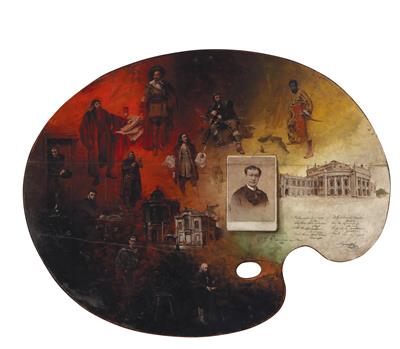Austrian Artist, Second Half of the 19th Century

Painter's palette with a trompe-l'oeil portrait of the imperial and royal court actor Adolph Sonnenthal (Pest 1834-1909 Prague) surrounded by depictions of his most successful roles, oil on panel, c. 62 x 80 cm, (Rei)
Provenance:
Private Collection Austria.
This lot is exceptional in several respects: in the centre of the composition is a portrait of the k. k. court actor Adolf Sonnenthal, which using the trompe-l'oeil effect looks like a pinned photograph, surrounded by depictions of the actor in his most successful roles. We see him clockwise starting at the top left as Nathan the Wise, his hand resting on an open book, next as Wallenstein from Schiller's drama of the same name, as William Tell, leaning on his crossbow, as the Moor Othello, in the middle right we could assume he is playing Faust, and at the bottom we see him in some boulevard roles, such as Fabricius with a top hat.
Sonnenthal was one of the most successful actors of his time. The son of a merchant from Pest discovered his passion for the stage at an early age and paved his way as an actor, even against resistance from his family. With the support of the Burgtheater actor Bogumil Dawison, who recognised his talent, he received his first engagement in Temesvàr, after which his reputation quickly spread. A stellar career followed, with stops in Königsberg and Dresden, until he first appeared at the Burgtheater in Vienna in 1856. There he was so successful that after three years, at the age of only 25, he was appointed k. k. court actor. He was a huge part of the Viennese theatre scene for several decades. On the occasion of his 25th anniversary of service, Emperor Franz Joseph made him a Knight of the Order of the Iron Crown.
Between the portraits of his various roles there is a depiction of the old Kärntnertor Theater in the centre and the new Burgtheater on the right edge, which certainly allude to the bon mot that Sonnenthal spoke the last words on the stage of the Kärntnertor Theater before its demolition and he then spoke the first in the new Burgtheater. This homage is completed by a poem that begins with the verses: "Soul painters we all are / the one good, the other bad / as a human painter you are unique / and your colour is faithful and genuine". In this sense, the present palette is certainly a gift of friendship that was probably presented to Sonnenthal on his departure from the Burgtheater on 1 May 1888. “Painted” palettes, such as the present one, came into fashion in the second half of the 19th century. They were initially executed on real painter's palettes, either by one artist repeating his most popular motifs “en miniature” or by a group of artists each contributing a small painting. The palette shown here was not created as a “painter's tool”, but rather as a picture support, which testifies to its large size and weight. It would be impossible to balance it on one hand. (KN)
Specialist: Mag. Dimitra Reimüller
 Mag. Dimitra Reimüller
Mag. Dimitra Reimüller
+43-1-515 60-355
19c.paintings@dorotheum.at
06.05.2021 - 15:15
- Realized price: **
-
EUR 1,920.-
- Estimate:
-
EUR 2,000.- to EUR 2,400.-
- Starting bid:
-
EUR 1,500.-
Austrian Artist, Second Half of the 19th Century
Painter's palette with a trompe-l'oeil portrait of the imperial and royal court actor Adolph Sonnenthal (Pest 1834-1909 Prague) surrounded by depictions of his most successful roles, oil on panel, c. 62 x 80 cm, (Rei)
Provenance:
Private Collection Austria.
This lot is exceptional in several respects: in the centre of the composition is a portrait of the k. k. court actor Adolf Sonnenthal, which using the trompe-l'oeil effect looks like a pinned photograph, surrounded by depictions of the actor in his most successful roles. We see him clockwise starting at the top left as Nathan the Wise, his hand resting on an open book, next as Wallenstein from Schiller's drama of the same name, as William Tell, leaning on his crossbow, as the Moor Othello, in the middle right we could assume he is playing Faust, and at the bottom we see him in some boulevard roles, such as Fabricius with a top hat.
Sonnenthal was one of the most successful actors of his time. The son of a merchant from Pest discovered his passion for the stage at an early age and paved his way as an actor, even against resistance from his family. With the support of the Burgtheater actor Bogumil Dawison, who recognised his talent, he received his first engagement in Temesvàr, after which his reputation quickly spread. A stellar career followed, with stops in Königsberg and Dresden, until he first appeared at the Burgtheater in Vienna in 1856. There he was so successful that after three years, at the age of only 25, he was appointed k. k. court actor. He was a huge part of the Viennese theatre scene for several decades. On the occasion of his 25th anniversary of service, Emperor Franz Joseph made him a Knight of the Order of the Iron Crown.
Between the portraits of his various roles there is a depiction of the old Kärntnertor Theater in the centre and the new Burgtheater on the right edge, which certainly allude to the bon mot that Sonnenthal spoke the last words on the stage of the Kärntnertor Theater before its demolition and he then spoke the first in the new Burgtheater. This homage is completed by a poem that begins with the verses: "Soul painters we all are / the one good, the other bad / as a human painter you are unique / and your colour is faithful and genuine". In this sense, the present palette is certainly a gift of friendship that was probably presented to Sonnenthal on his departure from the Burgtheater on 1 May 1888. “Painted” palettes, such as the present one, came into fashion in the second half of the 19th century. They were initially executed on real painter's palettes, either by one artist repeating his most popular motifs “en miniature” or by a group of artists each contributing a small painting. The palette shown here was not created as a “painter's tool”, but rather as a picture support, which testifies to its large size and weight. It would be impossible to balance it on one hand. (KN)
Specialist: Mag. Dimitra Reimüller
 Mag. Dimitra Reimüller
Mag. Dimitra Reimüller
+43-1-515 60-355
19c.paintings@dorotheum.at
|
Buyers hotline
Mon.-Fri.: 10.00am - 5.00pm
kundendienst@dorotheum.at +43 1 515 60 200 |
| Auction: | 19th Century Paintings and Watercolours |
| Auction type: | Online auction |
| Date: | 06.05.2021 - 15:15 |
| Location: | Vienna | Palais Dorotheum |
| Exhibition: | 03.05. - 06.05.2021 |
** Purchase price incl. charges and taxes
It is not possible to turn in online buying orders anymore. The auction is in preparation or has been executed already.
